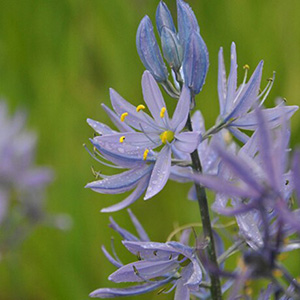Common Camas ~ Bundle of 3 Bare Root
- Current Stock:
- 0
- Other Names:
- Small Camas, Camas Lily, Swamp Sego
- Latin Name:
- Camassia Quamash
Like Great Camas, Common Camas is a stunning and iconic Northwest wildflower with a sweet, edible bulb and blue-purple flowers.
Edible Uses
The smaller (but equally sweet and more abundant) bulbs of Common Camas were also considered one of the most important root vegetables for trade in the traditional cultures of the Northwest. The longer they’re cooked, the sweeter they get. The taste is often compared to a baked pear, fig, or sweet potato, and they were even used to sweeten other foods. This native food can be eaten immediately after cooking, or dried for future use.
Camas is a major source of carbohydrates and fiber, with a small amount of protein. Bulbs can be eaten immediately after cooking, or dried for future use. This bulb is said to have saved the Lewis and Clark expedition from malnourishment in the cold winter months.
CAUTION: If harvesting from the wild, only harvest with expert advice. Especially when not in flower, Common Camas can be confused with another species called Death Camas.
Ornamental Qualities
Common Camas is not quite as large and showy as Great Camas, but is still widely propagated in the ornamental flower industry. The deep blue-violet flowers of the Common Camas are stunning, opening and closing in succession along a 12-24 inch flower stalk. At it’s base grows a rosette of long, narrow grass-like leaves. Great in flower beds, ornamental borders, and rock gardens.
Environment and Culture
Common Camas’ wild home is in wet meadows, wetlands, and moist hillsides up and down the Pacific Northwest. While it once grew in magnificent abundance in our region’s valleys, it has since been greatly diminished by urban development and agricultural practices. This is a very important plant to restore in our region. In certain places, it can still be found along a myriad of other native wildflowers like Chocolate Lily, Tiger Lily, and Leopard Lily, as well as wet-meadow grasses like Northwest Territory Sedge and Panicled Bulrush.
Camas is very low maintenance, needing moist soils and time to dry out during the summer months. This flower attracts many beneficial insects, especially bees. However, be aware of deer and burrowers who also like this tasty treat.
As a nutritious perennial, Camas has great potential for sustainable gardening and agriculture. In fact, Luther Burbank spent years breeding hybridizing Camas to create bulbs the size of small potatoes. With a little effort, Camas could once again be a no-till staple food of our region’s productive agricultural areas.
Harvest, Care, and Preparation
This is an easy plant to keep happy, as long as you can allow the soil to dry out during summer months. Camas can be allowed to grow and multiply from bulblets and seed prior to harvesting. The bulbs are best dug after the plant sets seed in mid-late summer.
The bulb pushes itself down as it grows and can be as deep at 6 inches. Take shovel or digging stick, and dig down, giving a wide berth. Sift the soil between your fingers to find the white bulb, and any bulblets that might be surrounding it. Replant seed and bulblets.
Traditionally, these prized bulbs were pit-cooked at low temperatures for at least 12 hours, allowing maximum conversion from inulin to fructose - making them sweet and sugary like a pear or fig. These days, we recommend baking in a casserole dish in the oven or in a slow-cooker for minimum 12-18 hours at 200-250 degrees - although one can extend the time for up to 36 hours for an even sweeter taste. Eating without cooking properly can lead to bitter tastes and indigestion. Check out this recipe on a related blog.
- Native Range: CA, OR WA, BC, NV, MT, WY, UT
- USDA zones: 3-7
- Ease of Care: Easy
- Deer Resistance: Low-Moderate
- Light Requirements: Prefers full sun/tolerates light shade
- Soil Type: Any, prefers well-drained.
- Water Requirements: Moist-Wet, drying out in Summer
- Pollination: Self-Fertile
- Bearing Age: 3-5 yrs from seed
- Size at Maturity: 12-24 inches
- Plant Spacing: 6-12 inches
- Bloom Time: Late Spring
- Harvest Time: preferably Mid-Summer




